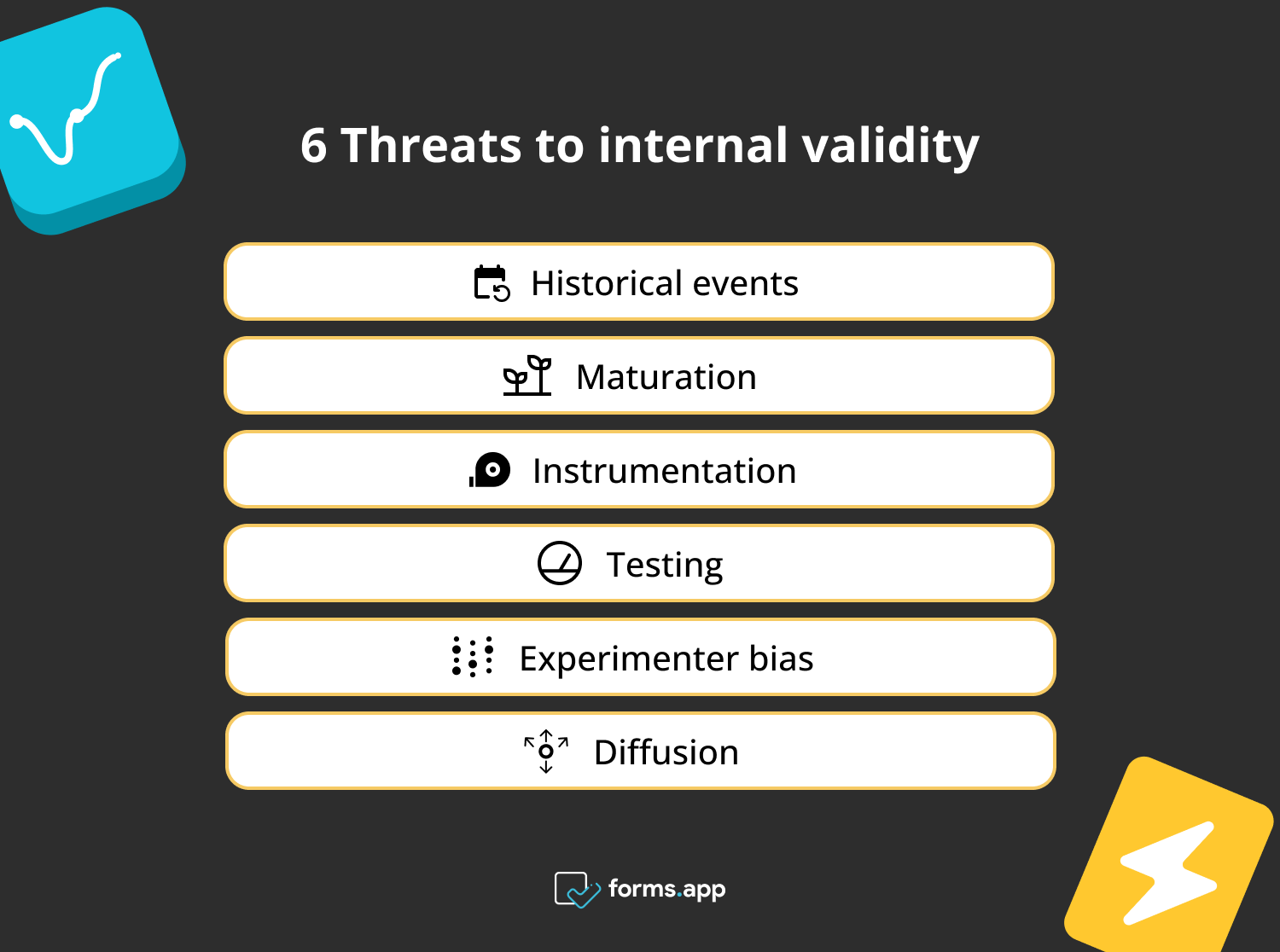The goal of every researcher conducting a study is to find a concrete outcome that has high internal validity. Because as the name suggests, internal validity stands for how valid the study is and how the result can not be linked to any other element.
And the difference in internal vs. external validity is that internal validity means that the study is valid and unbiased, whereas external validity means it can be generalized to other contexts. Now, let us go through the definition of internal validity, the possible threats, and examples.
What is internal validity?
Internal validity refers to the extent of confidence in the outcome of the research you are conducting. When the cause-and-effect relationship can not be explained by any other alternative explanations in research, that means internal validity is high and justified.

The definition of internal validity
In order to build internal validity, researchers must use appropriate study designs, such as randomized controlled trials, and carefully control for extraneous variables that could influence the result of the study. They must also make sure that their measures of the independent and dependent variables are reliable and valid. There are three necessary conditions for internal validity in psychological research:
- The cause and effect change together.
- The treatment occurs before changes in response variables.
- No confounding or extraneous variable can explain the results of the study.
6 Threats to internal validity

A list of threats to internal validity
The study outcome should not rely on any other factor for it to have high internal validity. Therefore, the researcher conducting the study must make sure all control variables are the same within the study group or groups. However, there are still some potential threats to internal validity that needs to be considered. And these threats are:
1 - Historical events
2 - Maturation
3 - Instrumentation
4 - Testing
5 - Experimenter bias
6 - Diffusion
1 - Historical events
Historical events that take place at the time of the study, or even before, may have an influence on the minds of research participants, and that can affect the result. For instance, if a researcher is doing a study on African-American groups in the United States about the racism factor in their lives, the start of the Black Lives Matter movement would influence their opinions and feelings on the subject.
2 - Maturation
If the study, experiments, and surveys take place over a long period of time, the overall study becomes vulnerable to the maturation effect. If the study participants become older or go through a biological (time) change, it may be difficult to make sure the time did not have any effect on them.
3 - Instrumentation
The methods of research should not be different in the pre-test and post-test testing process. If the researcher uses surveys and interviews in the pre-test period and uses the observation research method in the post-test period, this poses a threat to the internal validity of the study. This threat can also occur when the pre-test survey and the post-test survey durations change drastically.
4 - Testing
When the same testing method is used on the participants on a regular basis, it is possible for participants to get familiar with the tests or get used to the aim of the study. This repeated testing can impact the outcome significantly.
5 - Experimenter bias
When the researcher favors one group or acts differently against the treatment group or control group because of selection bias, it can have an impact on the participants. This bias from researchers affects the results and reduces the study’s internal validity.
6 - Diffusion
This happens when the spread of treatment effects from the experimental group to the control group. This results in resentful demoralization as the two groups interact with each other. The participants of one of the groups start working less complicated because they feel resentment towards their own group.
Examples of internal validity
The possible threats to internal validity can be eliminated by careful consideration when doing studies. Different experiments may require researchers to pay attention to different aspects of the study. Let us see some good and bad internal validity examples.
#1 Example of internal validity
A Company wants to find out whether or not a hybrid model of working (4 days working in the office and 1 day working from home) has a positive impact on the efficiency of employees’ time and their satisfaction levels. They randomly divide the employees into two groups and have one group work in a hybrid model and the other control group in the office full time.
They can use pre-test and post-test surveys to find out their job satisfaction levels. And they can measure their work to see if there is a major difference in the hybrid model group.
#2 Example of internal validity
A group of researchers wants to do an experiment on sleep conditioning in humans. The experimenters get a group of participants and their assistants who are blind to the goal of the study and divide these people into two different groups. After that, both groups are instructed to have a voice recording play in the room they sleep in.
Group A gets some stories played in the recording, but Group B gets motivational speech and affirmation recordings. However, the participants are told they will be tested on their sleep qualities. That means everything is as valid as possible for this study to have high validity.
#3 Example of internal validity
A researcher conducts an experiment on two groups to see if drinking a cup of coffee every day helps their memory levels. They divide the participants randomly; they are of similar ages and come from similar backgrounds. Group A drinks their coffee in the morning and takes surveys, and Group B drinks their water in the evening and takes surveys.
Because the two groups consume their drinks in different parts of the day, the result can not be solely linked to the fact that one group drinks coffee. That means this experiment is not valid enough.
Key points to take away
In order to make sure the study you do leaves no room for uncertainty or invalidity, some key points should be taken into consideration. The possible threats mentioned above can hinder the process and reduce the validity of the research. That is why researchers should know the internal and external threats and ensure they are not jeopardizing the research by their bias, methods of testing, or external elements. Here are some points to take away:
1 - Divide the control and treatment groups on a random assignment
Their qualities, opinions, or other variables should be divided equally to eliminate experimenter bias and achieve high internal validity. And if the participants are assigned to groups randomly and equally, that would mean the threats and external factors would be similar as well.
2 - Use filler tests, questionnaires, and surveys
Using filler tests and surveys is a good way to hide the true intentions of the study from the participants. By doing this, the researcher eliminates the diffusion and resentment within the study participants. For example, you want to figure out if an extra 20-minute break between lessons would improve student learning, and you give one group an extra break as the control group. The other group that does not get breaks may feel resentment toward the other participants.
3 - Use a large sample size
Using a large sample size would eliminate the threats in your study and ensure your research findings would be sensitive to other variables that might appear in the test. By eliminating possible threats you may not have thought about, you can make sure your research has high internal validity.
4 - Blinding
Blinding participants (sometimes even researchers) to the aim of the study can eliminate the risk of diffusion and experimenter bias. When the participants are blind to what the researchers are trying to find out, their perceptions will not impact the study’s outcome.
Conclusion
In conclusion, after going through all this information, it is safe to say it is up to the researchers to make sure their studies have high internal validity. They should mind every detail and make sure every step is controlled and checked. For this goal, a survey maker such as forms.app (with over 1000 templates!) can help with all kinds of research, and it is merely a screen away from you. Be sure to check it out for all your purposes!
forms.app, your free form builder
- Unlimited views
- Unlimited questions
- Unlimited notifications



